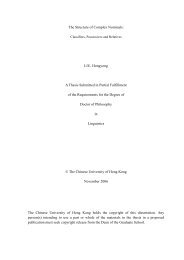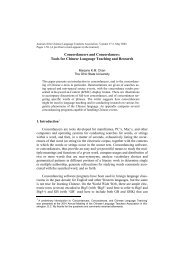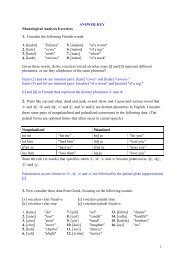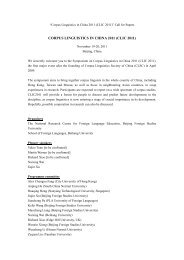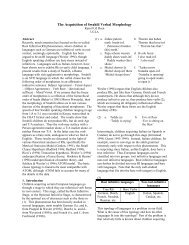The mnemonic keyword method: The effects of bidirectional retrieval ...
The mnemonic keyword method: The effects of bidirectional retrieval ...
The mnemonic keyword method: The effects of bidirectional retrieval ...
Create successful ePaper yourself
Turn your PDF publications into a flip-book with our unique Google optimized e-Paper software.
M. Wyra et al. / Learning and Instruction 17 (2007) 360e371<br />
363<br />
<strong>of</strong> themselves as imagers. <strong>The</strong> complete set <strong>of</strong> AMI items is shown in Appendix 1. Reliability analysis showed a Cronbach’s<br />
alpha <strong>of</strong> 0.89 with all items having high item-total correlations. To prepare students for the imaging questionnaires<br />
they listened to a fragment <strong>of</strong> Dahl’s (1982) book ‘‘<strong>The</strong> Twits’’ and were asked to think about what they ‘‘saw in<br />
their mind’’ when listening to the story. Students were not aware that VVIQ and AMI would follow.<br />
Based on paired rank classroom achievement scores students were randomly assigned to two groups, the standard<br />
<strong>keyword</strong> group and the <strong>keyword</strong> <strong>retrieval</strong> group. Students participated on six occasions (see Table 1). Occasion 0 provided<br />
training and practice in use <strong>of</strong> the <strong>keyword</strong> <strong>method</strong>. <strong>The</strong> next two sessions, Occasions 1 and 2, involved revision <strong>of</strong><br />
use <strong>of</strong> the <strong>method</strong>, then learning <strong>of</strong> the 22 SpanisheEnglish wordedefinition pairs at 20-s pace and then an immediate<br />
<strong>bidirectional</strong> recall test (Tests 1 and 2 in Table 1). This was designed to make the acquisition <strong>of</strong> word-meaning pairs as<br />
powerful as possible, within the limits <strong>of</strong> the time available. Occasions 0, 1 and 2 were conducted in small groups <strong>of</strong><br />
between five and eight students. <strong>The</strong> three delayed testing sessions (Occasions 3, 4 and 5) occurred once each week<br />
for the next 3 weeks. All sessions were <strong>of</strong> the same duration for both the standard group and the <strong>retrieval</strong> group.<br />
Twenty eight concrete two- and three-syllable nouns were chosen for this study. Six words were used as instruction/<br />
practice words, with the remaining 22 words being used as target words in the learning/testing part <strong>of</strong> this study. Care<br />
was taken to ensure that all the words were new for the students, first through consultation with teachers and then<br />
through pilot testing with students in a parallel Spanish program in a nearby school.<br />
<strong>The</strong> training instructions for students were prepared as booklets that were studied by students under the guidance <strong>of</strong><br />
the researcher. <strong>The</strong> scripts in the booklets were adapted from those described by Lawson and Hogben (1998). Using<br />
Lawson and Hogben’s (1998) elaborated version <strong>of</strong> encoding, three main conditions were imposed on the process <strong>of</strong><br />
linking the image <strong>of</strong> definition and the image <strong>of</strong> <strong>keyword</strong> into the interactive image. <strong>The</strong>se conditions were (1) there<br />
are only two images in the interactive pictures; (2) the image <strong>of</strong> the definition has to be bigger than the image <strong>of</strong> the<br />
<strong>keyword</strong> image; and (3) if possible, the interactive image should be funny or unusual.<br />
<strong>The</strong> scripts were supplemented with three posters that contained graphical illustration <strong>of</strong> the key steps in the<br />
encoding (IN) and in the two directions <strong>of</strong> <strong>retrieval</strong> (OUTf for forward recall training, OUTb for backward recall training)<br />
uses <strong>of</strong> the <strong>keyword</strong> procedure. <strong>The</strong> standard <strong>keyword</strong> group used only the IN poster and the <strong>keyword</strong> <strong>retrieval</strong><br />
group was shown all three posters. For both the standard and <strong>retrieval</strong> groups, the <strong>keyword</strong> generating and image<br />
generating steps were explained using the Spanish word camarera (waitress) and possible <strong>keyword</strong>s and interactive<br />
images, and desirable qualities <strong>of</strong> the images were discussed. Students in both groups practised immediately on two<br />
new words (jacal, grossella) and then standard group practised encoding with another three new words (tomada, mancha,<br />
cazador), with students in the standard group having time to discuss the possible <strong>keyword</strong>s and images throughout<br />
the training session. Students in the <strong>retrieval</strong> group were given additional training in how to use the <strong>keyword</strong><br />
procedure to retrieve bi-directionally (forward and backward). With the assistance <strong>of</strong> the ‘‘OUT’’ posters (OUTf<br />
and OUTb), they practised the <strong>retrieval</strong> <strong>of</strong> all the training words jacal and grossella) and practised encoding and <strong>retrieval</strong><br />
<strong>of</strong> three new words (tomada, mancha, cazador). For forward <strong>retrieval</strong> the OUTf poster identified a set <strong>of</strong> steps,<br />
starting with examination <strong>of</strong> the FL word for presence <strong>of</strong> a <strong>keyword</strong>, making a search for images involving the <strong>keyword</strong><br />
that had the characteristics emphasised as being desirable during the <strong>keyword</strong> <strong>method</strong> training, and scanning the<br />
image generated to identify the most prominent component <strong>of</strong> the image, which is expected to be the definition. In the<br />
case <strong>of</strong> backward <strong>retrieval</strong> the OUTb poster steps began with a search for any images <strong>of</strong> the definition. <strong>The</strong> next steps<br />
Table 1<br />
Training, learning and testing procedures<br />
OCCASION STANDARD RETRIEVAL<br />
0 Keyword <strong>method</strong> training (encoding) Keyword <strong>method</strong> training (encoding)<br />
Bidirectional <strong>retrieval</strong> training<br />
1 Recap <strong>of</strong> first session (occasion 0) Recap <strong>of</strong> first session (occasion 0)<br />
Learning 22 SpanisheEnglish wordedefinition pairs<br />
Learning 22 SpanisheEnglish wordedefinition pairs<br />
Test 1 Test 1<br />
2 Learning words again Learning words again<br />
Test 2 Test 2<br />
3 Test 3 Test 3<br />
4 Test 4 Test 4<br />
5 Test 5 Test 5



